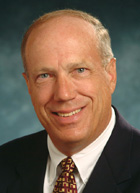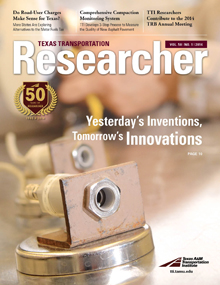Research is a Bridge.

Agency Director
In its simplest form, research involves taking what we know and building on it. The empirical process is how we explore possibilities, test new theories about old assumptions, and ultimately, through innovation, create a roadmap to a better future.
But new ideas have to come from somewhere. At the Texas A&M Transportation Institute (TTI), they’re developed through a careful, investigative process that, ironically, examines what we think we know to determine how much we don’t know. Through research, we discover the cracks in our armor (and our pavements), but we also figure out how to rehabilitate those cracks via implementable findings. The state of the art — through research — becomes the state of the practice.
Thomas Scullion has mastered that process like few others. Tom is a senior research engineer for TTI and manages our Flexible Pavements Program. For decades, his ability to think outside the pavement rehabilitation box has revolutionized road maintenance. This issue of the Texas Transportation Researcher highlights his latest idea: the Comprehensive Compaction Monitoring System. Tom has taken his past inventions and combined them into a seamless process that can preserve our roadways longer and more cost-effectively while providing safer travel for motorists — nothing new for Tom, really.
As you’ll see in these pages, other TTI researchers are paving new ground as well. In the next few decades, Austin is facing a tremendous mobility challenge as its population nearly doubles. A TTI team recently modeled that future reality to help stakeholders in the Texas capital avoid a driving dystopia.
Part of making transportation better in the future is figuring out, today, how to pay for the system we need for vital economic growth and a desirable standard of living. For example, TTI researchers are studying how other states are using road-user fees as one option for supplementing diminishing gas-tax revenues. And new partnerships — like TTI‘s LINK Alliance with the University of Michigan Transportation Research Institute — can leverage the best that each partner offers to produce research findings greater than the sum of the parts.
If you’ll indulge me a moment, I’d like to note two landmarks in 2014. Since its inception in 1965, the Researcher has shared TTI innovations — our contribution to the process of building on what we know to improve what we have — with the world. We invite you to celebrate with us 50 years of spreading the good word by turning this page. You’ll no doubt note how the magazine itself has been innovated over time to meet the needs of its evolving readership.
The second landmark occurred on Feb. 19, when TTI welcomed its latest inductee into the Texas Transportation Hall of Honor. For 13 years, Herbert H. Richardson, my predecessor, served as director of TTI. In many ways, Herb’s vision for what the Institute could be established TTI as the internationally recognized expert in transportation it is today. We honor Herb’s contributions — both to the Institute as our director emeritus and to our global transportation system — with his induction.
Giants like Herb, Tom and TTI‘s other outstanding thought leaders continue to move us forward with their original thinking and their desire to transition the transportation system we have to the one we need. Their research helps make our transportation future one I look forward to sharing. I’m honored to work beside them at TTI.

